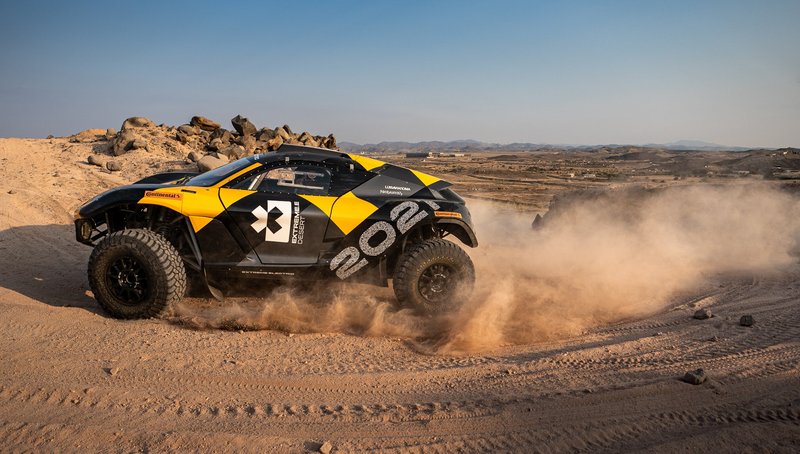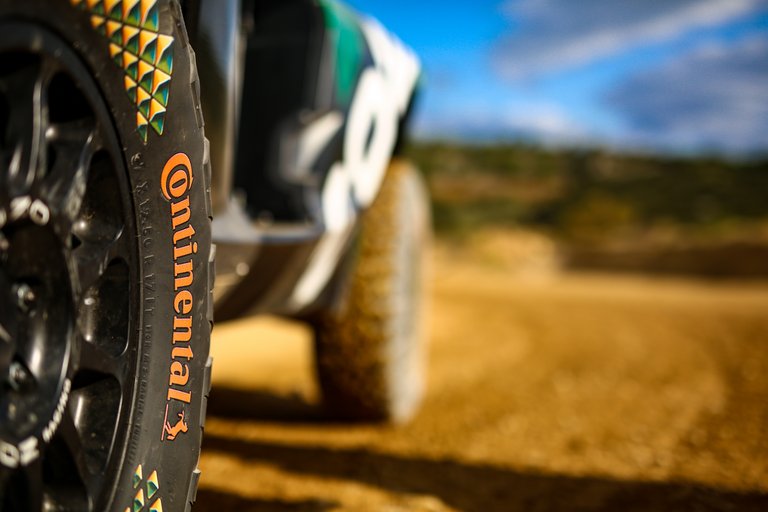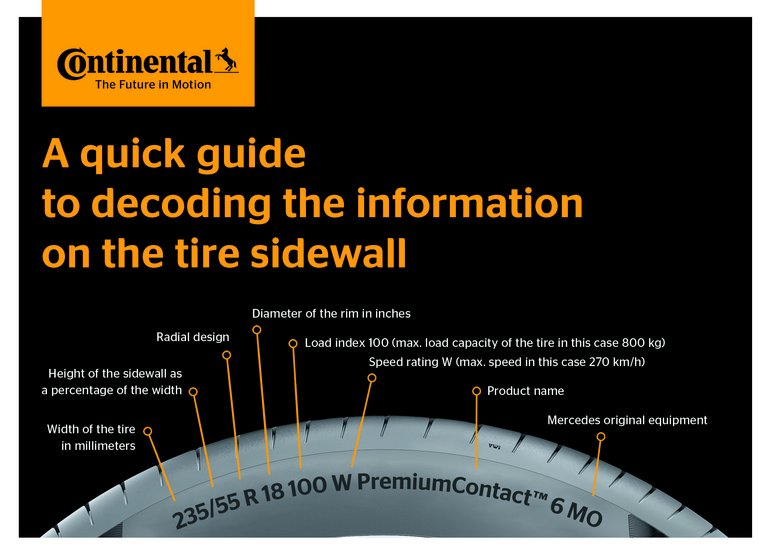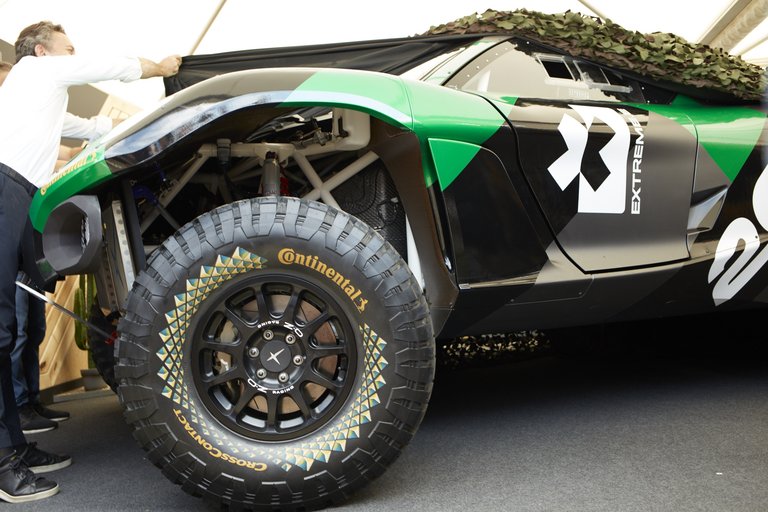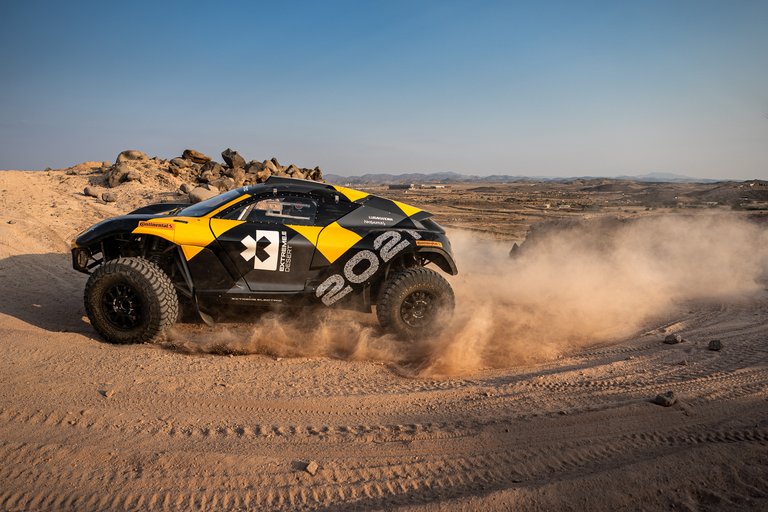“The biggest challenge that tires have ever had to face in motor sport”
- Continental special tires for the E racing ODYSSEY 21 race car
- The racing series launches in March 2021 at Lac Rose in Senegal
- Interview with Nico Meier, Product designer at Continental
Hanover, July 2020. Continental is a founding partner and, from 2021, the premium sponsor of the Extreme E series. The technology company will equip all vehicles in the races with tires for the different and very challenging action.
In the interview, Nico Meier, product designer at Continental, talks about the special challenges that the tires are exposed to in this series, the importance of the tire sidewall in general, and its role in the sidewall design of the Extreme E tire in particular.
Continental: Nico, what is the task of the sidewall of a tire from the viewpoint of a technician?
Nico Meier: The sidewall plays a key role in the overall construction of a tire in the truest sense of the word. Modern mid-size class vehicles now regularly have a permissible gross vehicle weight of 1,500 to almost 2,000 kilograms. The increasingly popular SUVs come to three metric tons. That's roughly the same weight as a full-grown hippo.
Continental: But the whole weight doesn't rest entirely on the sidewall of the tire, does it?
Nico Meier: No. In fact, the sidewall is actually the weakest component compared to the tread that connects the vehicle to the road surface – or the bead that holds tires on the rim. For this reason, you should never direct a pressure washer onto the flank at close range. It could actually be damaged. The load-bearing element in the tire is essentially the air or gas mixture trapped under overpressure. Technicians calculate the load capacity of an ideal diaphragm in accordance with the "internal pressure x contact surface" function. In the case of tires, the stiff shell structure adds an additional load-bearing component of 10 to 15 percent.
Continental: That sounds like a surprisingly simple formula. Is it really that simple?
Nico Meier: In theory, yes. The load capacity of a tire depends largely on the internal pressure. The sidewall is the crucial element in the shell structure. As a result, it also has an affect on the load capacity and can also compensate for lower pressures to a certain extent. For example, tires with SSR technology (Self Supporting Runflat) have a reinforced sidewall. This means that even with total pressure loss, you can still drive at low speed to the nearest auto repair shop. However, the crucial factor is the internal pressure. By the way, this should also demonstrate why too low an air pressure can become a fatal hazard. A large proportion of all accidents caused by defective tires are due to insufficient air pressure. It really makes sense to check the barometric pressure once a week.
Continental: So generally speaking it would be better if the sidewall was designed to be more stable, right?
Nico Meier: A stable sidewall has advantages – and not just when it comes to pressure washers. In the case of tires, however, everything is always connected to everything else, so the sidewall doesn't just play a key role in the overall design. Together with the belt, it has a significant effect on the handling properties of a vehicle, among other things. A relatively stiff structure reduces the deformation of the tire during power transmission – i.e. during acceleration, braking and cornering. This improves the handling characteristics and increases the possible cornering speeds. However, a tire that is too stiff can no longer deflect, and thus has a negative effect on comfort, for example.
Continental: And why does the sidewall need a design?
Nico Meier: There are two main reasons for this. Firstly, the legislator requires manufacturers to provide a lot of details. These are intended to increase road safety, among other things, by helping to prevent tires from being fitted on a vehicle that are not suitable due to their size or quality. For example, tires that are designed by the manufacturer based on the load capacity for small cars are completely unsuitable for a heavy-duty sedan in the premium class. Secondly, manufacturers link their own marketing strategic goals, such as brand presence and recognition, with the design.
Continental: What are the requirements of the legislator?
Nico Meier: These are primarily technical details such as tire width, height-to-width ratio, rim diameter, load index, approved speeds. But also information on the intended use. For example, is this a summer, winter or all-season tire? The production date is also included, the country of manufacture, and approval numbers. In the case of directional tires, there is also an indication of how the tire is to be fitted. To clearly delineate the information required by the legislator from the rest, the sidewall is divided into two zones: the inner and outer ring. The legally regulated elements are found in the inner ring. That's the one closest to the rim. In terms of design, we have virtually no influence on this.
Continental: Which strategic aspects of marketing is your work focused on?
Nico Meier: As I mentioned, this is primarily about recognizability. Drivers who buy a tire from Continental are purchasing a premium product of the highest quality, one which has proven its far higher than average performance in the comparison tests of the automotive trade press. So it's important to us that the origin of the tire is apparent when you look at it. The brand logotype and product name are therefore important design elements that should be recognized by the viewer straightaway. The sidewall is supplemented by special design elements. These highlight important properties of the tire, visualize areas of application, and underline the uniqueness of a product.
Continental: You also designed the tires that are supplied exclusively by Continental to the teams in the new Extreme E racing series. What distinguishes this tire from conventional tires.
Nico Meier: The tire is exposed to much larger loads during the races than any other tire. This is due firstly to the vehicles used. The specially-developed ODYSSEY 21, which is driven by all of the teams, is an extraordinary vehicle which is roughly similar to commercial SUVs in length, width and weight, but with its electrical equivalent of 550 HP has three times the torque of the Formula E Gen 2 vehicle. Secondly, the races do not take place on standardized race tracks with comparable road surfaces, but in a natural environment with varying and very different surfaces: sand, scree, mud, ice, to name but a few. Added to this is the general race situation with extreme accelerations, violent braking maneuvers, high speeds, even on tight corners, drift movements, and even jumps. We are dealing with the biggest challenge that tires in motorsport have to face. With the help of ContiPressureCheck technology, tire data such as the air pressure and temperature should therefore be displayed on a screen in the cockpit during the race for the drivers, so they can adapt their driving style in extreme situations.
Continental: The challenges on the tires are very different from race to race, because the venues are so different. Sometimes it's through the desert, another time through the rainforest or even the Arctic. Is there a special tire for every race?
Nico Meier: No. Using the tried-and-tested Continental CrossContact, we have developed a tire that should work at all event locations and in all conditions. So there's no special desert tire, or a special polar tire. Nor is it the intention to fit new tires for every start. This would also not be in line with the sustainability requirements of the racing series. In other words, the tires do not differ visually from one another.
Continental: Are there legal requirements for the sidewall design for these special products?
Nico Meier: No. However, the tires for the Extreme E racing series also have some important information on the edge of the rim – for example, "Only for racing," so it is clear that this tire cannot be purchased commercially. Since this inner ring is correspondingly small, we have more space for individual design. This is a rare stroke of luck that we have to capitalize on.
Continental: What immediately catches the eye is the unusual color...
Nico Meier: The design of the tire is divided into four zones. One zone contains the Continental logotype, another the product name CrossContact – both in Conti yellow. In between are zones with multi-colored structures. This colorfulness is a striking contrast to conventional tires. We decided on this for two reasons. Firstly, unlike products in the retail sector, these tires will rarely be seen at close proximity. Thanks to the colored highlighting, we achieve improved visibility at greater distances and on digital media. And secondly, with the color of the design elements, we want to reflect the extreme and breathtaking natural landscapes in which the races are held. Green is the color of the rainforest, yellow stands for desert sand and sandstone mountains, blue for the ocean, and white for the Arctic. In addition, we have created a 3D effect that gives the elements the appearance of a protective layer – similar to a dragon’s skin or a lizard’s scale armor. In doing so, we highlight the extremely robust and resilient character of the tire. During the races, the rotation creates a fascinating flow effect.
Continental: How do the tires get the color?
Nico Meier: For this, we use so-called post-cure technology. In this process, labels with colored elements are printed onto the sidewall of the tire afterwards. As a designer, this process provides me with all-new possibilities to visually present information about the product. A specially-developed color mixture is used for the labels, which is characterized by strong adhesion to the tire and is therefore well suited to the racing series.
Continental: A racing tire is subject to different loads than an ordinary tire. Did you have to take this into account in any way in terms of design?
Nico Meier: The extreme loads result in the tire undergoing relatively high deformation during the race. This also results in significant temperatures. We cannot rule out the possibility that the design elements will be damaged. Especially since abrasions are also possible in the event of unintentional contact with the vehicle's surroundings. We are therefore developing special repair kits for the sidewall design which we can use to restore tires that were only visually damaged during the races, on location between the individual stages. However, the final concept for this has not yet been determined.
Continental: Could the coloring process also be used for conventional series products?
Nico Meier: Yes. That could be done without making any changes. We can imagine it being used in particular in "special interest" tires, such as all-terrain tires or racing tires with road registration. Standard tires will certainly also shine in plain black in the future.
Thank you for your time, Nico.
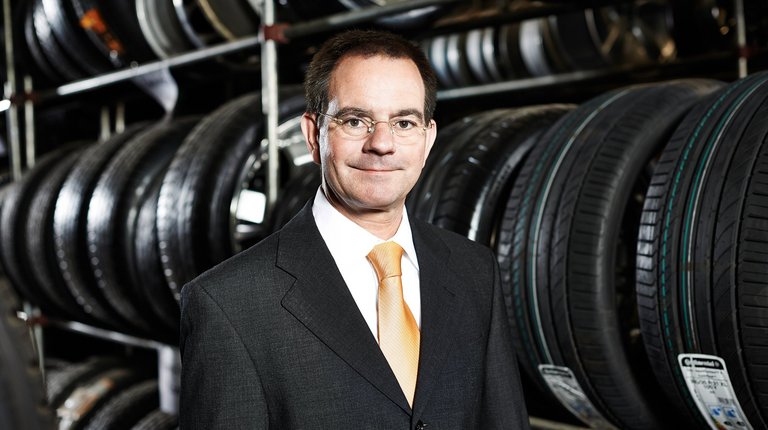
Klaus Engelhart
Press Spokesman
Passenger Car Tires / Germany, Austria, Switzerland
- +49 511 938-2455
